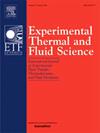Interfacial characteristics of a perturbed liquid jet in quiescent air
IF 3.3
2区 工程技术
Q2 ENGINEERING, MECHANICAL
Experimental Thermal and Fluid Science
Pub Date : 2025-09-04
DOI:10.1016/j.expthermflusci.2025.111603
引用次数: 0
Abstract
The physical understanding of liquid jet breakup in quiescent air remains incomplete due to the complex interactions among influencing parameters and limitations in current measurement techniques. In this study, a needle pin was positioned at the nozzle exit of a liquid jet pressure atomiser to introduce an artificial perturbation of controlled magnitude, enabling an investigation on the influence of flow disturbances on the breakup process. This perturbation is introduced to model potential flow disturbances that may occur inside the nozzle of an atomiser, such as liquid flow separation or cavitation. The interfacial characteristics of the liquid jet, including surface morphology and interfacial motion, were analysed to assess the impact of the imposed perturbation on the breakup process. Optical Connectivity (OC), which transmits a laser beam through the intact liquid core, was employed to capture detailed interface geometry. The instantaneous interfacial characteristics were tracked in time using Optical Flow Velocimetry (OFV) to measure the interfacial velocity. Proper Orthogonal Decomposition (POD) was applied to extract the dominant interfacial wave structures, which were subsequently correlated with interfacial motion to provide a comprehensive assessment of the perturbation effects. The consistency between the dominant interfacial geometry extracted from POD and the measured interfacial velocity further validates the reliability of the OC-OFV technique. The findings reveal that introducing artificial perturbations and adjusting their amplitude can alter the interfacial motion and geometry of the liquid jet by modifying internal flow patterns, which in turn influence the liquid breakup process and the velocity of the resulting liquid fragments. This highlights the significant impact of nozzle disturbances, such as cavitation or manufacturing defects, on atomisation performance. Moreover, the results suggest that applying controlled artificial perturbations could serve as an effective strategy for controlling the breakup process and optimising the resulting spray droplet velocity.
静空气中扰动液体射流的界面特性
由于影响参数之间复杂的相互作用和现有测量技术的局限性,对静止空气中液体射流破裂的物理认识仍然不完整。在本研究中,在液体射流压力喷雾器的喷嘴出口处放置一个针脚,以引入一个可控量级的人工扰动,从而研究流动扰动对破裂过程的影响。引入这种扰动来模拟可能发生在喷雾器喷嘴内部的潜在流动扰动,例如液体流动分离或空化。分析了液体射流的界面特征,包括表面形貌和界面运动,以评估施加的扰动对破裂过程的影响。光学连通性(OC)通过完整的液体核心传输激光束,用于捕获详细的界面几何形状。利用光流测速仪(OFV)测量界面速度,及时跟踪界面的瞬时特性。应用适当正交分解(POD)提取界面波的优势结构,并将其与界面运动进行关联,从而对扰动效应进行综合评价。从POD中提取的优势界面几何形状与实测界面速度之间的一致性进一步验证了OC-OFV技术的可靠性。研究结果表明,引入人工扰动并调节其振幅可以通过改变内部流动模式来改变液体射流的界面运动和几何形状,从而影响液体破碎过程和产生的液体碎片的速度。这突出了喷嘴干扰(如空化或制造缺陷)对雾化性能的重大影响。此外,研究结果表明,施加可控的人工扰动可以作为控制破碎过程和优化最终雾滴速度的有效策略。
本文章由计算机程序翻译,如有差异,请以英文原文为准。
求助全文
约1分钟内获得全文
求助全文
来源期刊

Experimental Thermal and Fluid Science
工程技术-工程:机械
CiteScore
6.70
自引率
3.10%
发文量
159
审稿时长
34 days
期刊介绍:
Experimental Thermal and Fluid Science provides a forum for research emphasizing experimental work that enhances fundamental understanding of heat transfer, thermodynamics, and fluid mechanics. In addition to the principal areas of research, the journal covers research results in related fields, including combined heat and mass transfer, flows with phase transition, micro- and nano-scale systems, multiphase flow, combustion, radiative transfer, porous media, cryogenics, turbulence, and novel experimental techniques.
 求助内容:
求助内容: 应助结果提醒方式:
应助结果提醒方式:


